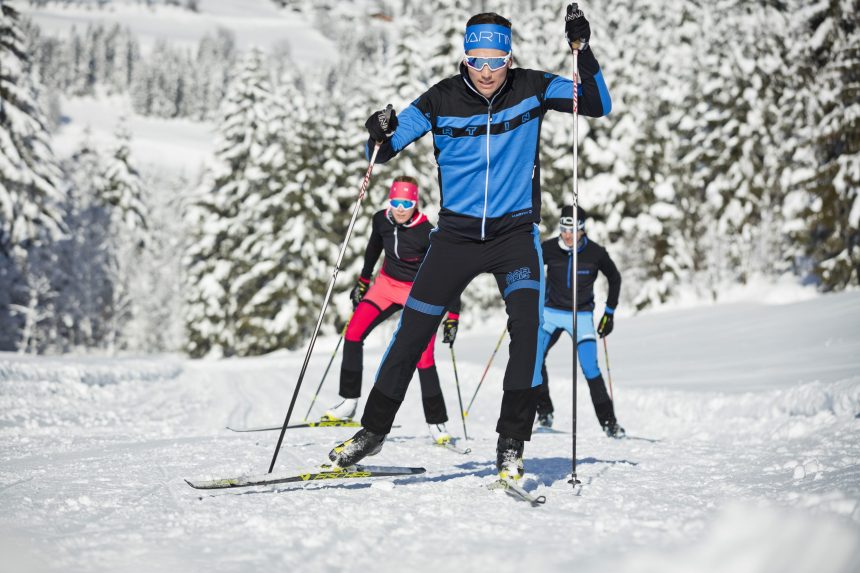Incorporating stretching and mobility exercises into your fitness routine is crucial for overall health, especially when engaging in a sport like skiing that taxes various muscle groups and cardiovascular systems, while also challenging endurance, power, stability, and focus. According to Levi Frasier, PT, DPT, a physical therapist and clinic director of Peak Physical Therapy, stretching is essential for skiers of all levels as it can help prevent injuries, enhance on-slope performance, and alleviate post-ski soreness.
Frasier suggests different stretching approaches for pre and post-skiing sessions. Dynamic stretches or mobility exercises, which involve active movements, are ideal for pre-ski warm-ups as they promote blood flow and prepare the nervous system for activity. On the other hand, static stretching, involving holding a stretch, is recommended for post-skiing recovery. These stretches aid in relaxation, regulate breathing, and promote a calm nervous system.
Below, we’ve outlined some of the most effective stretches for skiers to perform before and after hitting the slopes. These stretches not only help prepare the body for skiing but also reduce the risk of injury.
Pre-Ski Stretches
Stretching is a valuable practice for enhancing flexibility, preventing injuries, maintaining posture, and expanding range of motion, explains Jesse Stormer, BSc, MSc, a PSIA-certified alpine ski instructor and owner of Stormer Performance.
“In both skiing and daily activities, we often adopt compensatory movement patterns that enhance efficiency but can also lead to discomfort and pain,” he notes. “For many of us, skiing without injury or discomfort is the ultimate goal.”
Before hitting the slopes, it’s crucial to perform dynamic stretches gradually, then increase speed and intensity as long as there’s no pain. Here are some stretches to consider before skiing.
Hook-Lying Reach
Stormer recommends the hook-lying reach as an effective movement to alleviate tension in the lower back before stretching, particularly targeting the erector spinae muscles responsible for straightening and rotating the back. This stretch is particularly valuable because many individuals carry significant tension in their lower back, leading to potential back pain.
“Releasing this tension before hitting the slopes not only protects the back but also supports the health of the knees and hips,” Stormer advises.
He further explains that when tension accumulates in one area of the body, it can result in pain elsewhere due to compensatory mechanisms, also known as referred pain. To alleviate tension before skiing, try the following reaching movement:
- Lie face up with palms facing up.
- Bend your knees and place both feet on the floor evenly, applying equal pressure through both feet.
- Raise your arms straight up until they are perpendicular to the ground.
- Maintain straight arms with palms facing toward you and twist them without bending elbows. Rotate thumbs toward your feet and pinkies toward your face.
- Breathe gently into your low back, feeling it pressing into the floor with each breath.
- Repeat for five breaths.
Seated Reach
Stormer recommends the seated reach as a progression from the hook-lying reach, which further aids in relaxing the lower and upper back. Here’s how to perform the seated reach:
- Sit with your back against a wall for support.
- Bend your knees to about 90 degrees, bringing them toward your chest, with your feet flat on the floor and weight evenly distributed.
- Extend your arms forward, keeping your palms facing the ceiling.
- Hinge forward at the waist, bringing your chest toward your knees, allowing your back to round naturally.
- Place your hands on the outside of your knees, reaching slightly toward the floor with palms facing up.
- Gently breathe into your lower back, feeling it expand with each breath.
- Repeat for five breaths.
Half-Kneeling Quadriceps Stretch
Stormer recommends trying the half-kneeling stretch to release tension in the front of the hips, especially targeting the quadriceps muscle group. Here’s how to perform the half-kneeling quadriceps stretch:
- Begin in a half-kneeling position with one knee on the floor and the other knee bent at a 90-degree angle.
- Optionally, place a pillow or towel under the knee that’s on the floor for added comfort.
- Gently push your hips forward until you feel a stretch in the front of the thigh of the knee that’s on the floor.
- Hold the stretch for about 30 seconds, focusing on maintaining steady breathing.
- Switch sides and repeat the stretch with the opposite leg in front.
Frog Pose Groin Stretch
The Frog Pose groin stretch, recommended by Stormer, targets the inner legs and hips, specifically working to loosen the adductor muscles and reduce tension in the front of the pelvis. Here’s how to perform it:
- Start on your hands and knees.
- Lower your hips toward your calves while maintaining a bent-knee position.
- Spread your knees apart, keeping the inside of your shins in contact with the ground.
- To deepen the stretch, sit back further or widen the distance between your knees.
Lunges
According to Fraiser, lunges are effective for warming up the lower body muscles, loosening the joints, and improving range of motion. Here’s how to perform a lunge:
- Stand tall with an upright posture.
- Step forward with one leg, reaching out to touch the heel first with a long stride while the back knee approaches the floor.
- Push off the front heel to return to the standing position.
- Alternate legs and repeat for one to two minutes.
Frankensteins
Frankensteins, a dynamic movement suggested by Fraiser, target the hamstrings, which often become tight after downhill skiing and are crucial for uphill climbing. Here’s how to perform Frankensteins:
- Stand tall with proper posture.
- Reach forward to touch the floor while keeping your back straight until you feel a slight pull in the back of your leg (hamstrings).
- Simultaneously, extend your opposite leg backward while leaning your trunk forward.
- Take a few steps forward and repeat the movement with the opposite leg.
- Continue alternating legs and repeat the exercise for one to two minutes.
Groin Stretch
The groin stretch involves side-to-side movements to warm up the medial hip muscles, according to Fraiser. Here’s how to perform it:
- Stand tall with your legs apart, slightly wider than shoulder-width apart.
- Slowly shift your weight from one side to the other until you feel a gentle pull in your inner thigh.
- Alternate shifting your weight back and forth slowly for one to two minutes.
Pre-Ski Jumps
Fraiser suggests that jumps enhance dynamic control while loading the lower extremities, which aligns with skiing movements. Warming up with exercises that mimic the actions you’ll be performing is crucial for preparation and injury prevention. Here’s how to do pre-ski jumps:
- Stand tall with your feet shoulder-width apart.
- Bend your knees and crouch down with your hips pushing backward.
- Jump slightly forward and to the side, landing with your feet shoulder-width apart and absorbing the impact through your legs.
- Jump slightly forward and to the opposite side.
- Repeat the left and right jumps ten times each.
- Perform the jumps with slow and controlled movements to maintain balance and avoid relying on momentum.
Post-Ski Stretches
Stormer recommends integrating the hook-lying reach and seated reach into your post-ski cool-down routine. “These movements are beneficial for releasing the tension accumulated during a day of intense skiing.”
Following these, consider adding more stretches to your routine. Here are a few options to consider.
Heel Elevated Toe Touch
The heel elevated toe touch combines elements from both the hook-lying and seated reaches, according to Stormer. “It’s a classic hamstring stretch that effectively targets the lower back while also providing a deep stretch for the hamstrings.”
The hamstrings play a crucial role in skiing, and they are prone to fatigue and tightness, especially with consecutive days of skiing. Proper care of these muscles is essential for maintaining flexibility and preventing injury. Here’s how to perform the heel elevated toe touch:
- Place a book or elevated surface under your heels while keeping the balls of your feet on the ground.
- Reach forward towards your toes, mimicking a traditional toe touch.
- As you exhale, engage your abdominal muscles and deepen the stretch.
- Focus on feeling the stretch in your hamstrings and lower back.
- Repeat for 10 breaths, allowing yourself to relax into the stretch with each exhale.
Standing Quadriceps Stretch
Fraiser recommends stretching the quadriceps muscles, which are heavily engaged during skiing movements, to alleviate post-activity soreness commonly experienced in skiing. Here’s how to perform a standing quadriceps stretch:
- Stand tall with proper posture.
- Hold onto one ankle with the hand on the same side, keeping the knee bent.
- Tuck your tailbone underneath your body to create a gentle stretch in the front thigh muscle.
- Hold the stretch for 30 seconds, focusing on breathing deeply and relaxing into the stretch.
- Repeat the stretch three times on each side.
- Switch to the other side and repeat the process to stretch both quadriceps muscles evenly.
Standing Hamstring Stretch
Frasier emphasizes the importance of hamstring stretching to prevent injuries like hamstring pulls. One effective stretch for this purpose is the standing hamstring stretch. Here’s how to perform it:
- Stand tall with good posture.
- Place one foot slightly in front of the other in a staggered stance position.
- Hinge forward at the hips while keeping your back straight, aiming to feel a gentle stretch along the back of the thigh of the extended leg.
- Hold the stretch for 30 seconds, focusing on maintaining a steady breath.
- Repeat the stretch three times on the same side.
- Switch legs and repeat the stretch on the opposite side to ensure both hamstrings are properly stretched.
Standing Calf Stretch
During skiing, your calves undergo significant strain and may become tight and achy. To alleviate this discomfort, Fraiser recommends two variations of the standing calf stretch:
Staggered Stance Calf Stretch:
- Stand upright with your feet in a staggered stance.
- Shift your body weight forward onto your front foot while keeping your back leg straight, until you feel a gentle stretch in the back of your lower leg (the calf).
- Hold the stretch for 30 seconds and repeat three times.
- Switch legs and perform the stretch on the opposite calf.
Bent Knee Calf Stretch:
- Assume the same staggered stance as before.
- Lower your back knee to the ground, bending it gently, while maintaining the front leg straight.
- Lean forward slightly to deepen the stretch in the posterior leg (calf).
- Hold the stretch for 30 seconds, repeating three times.
- Switch legs and repeat the stretch on the opposite calf.










